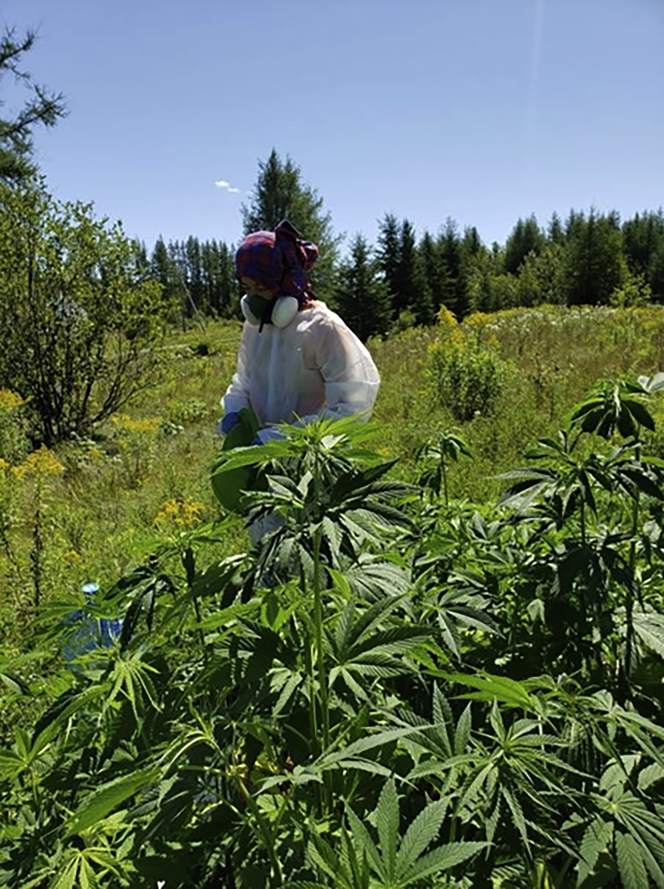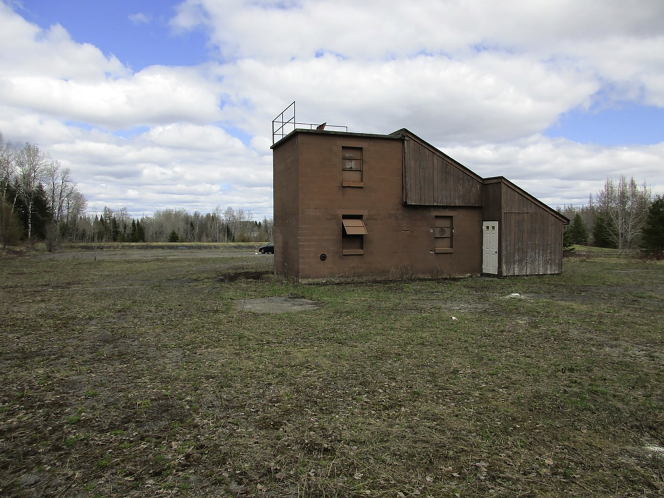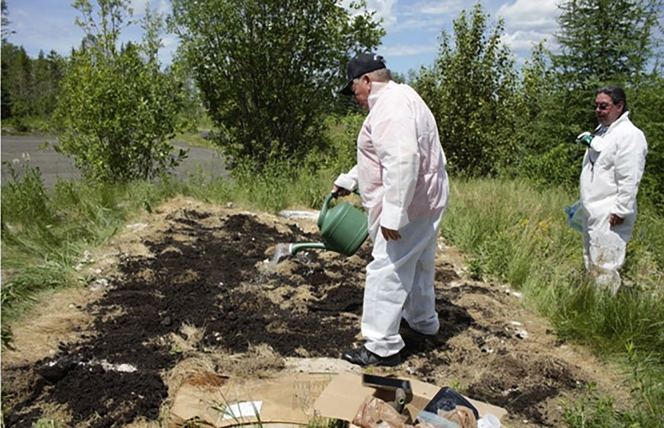The pair was hardly dressed like typical farmers, but this was no typical farm. Sporting white hazmat suits and respirators, Chelli Stanley and Richard Silliboy lugged 5-gallon jugs of water toward bushy plots of hemp, each 30-by-30-foot patch a stark sign of order in the otherwise overgrown field. It was a warm September day in Limestone, a small town on the edge of the Maine-Canada border, and the pair struggled to breathe in the head-to-toe protective gear. Stanley, a founder of the environmental organization Upland Grassroots, recalls telling Silliboy, vice chief of the Aroostook Band of Micmac Nation, “This will be worth it someday.”
For Stanley and Silliboy, the focus was not so much the hemp they were growing as what it was doing. Their farm, once part of the Loring Air Force Base, is also a Superfund site — an area so polluted it’s marked high-priority for federal cleanup. Later, when the Aroostook Band of Micmacs took over the site’s ownership, they found its soil was rife with per- and polyfluoroalkyl substances, better known as PFAS, cancer-causing compounds that are so difficult to break down they’re commonly known as “forever chemicals.”
Because of their ability to bind to proteins, PFAS tend to bioaccumulate — building up in soil, water, and even human bodies. Under typical environmental conditions, they can persist for hundreds, even thousands of years. But there is hope at Loring: In 2020, researchers discovered that the Micmacs’ hemp plants were successfully sucking PFAS out of the contaminated soil. This practice, known as phytoremediation, could guide farmers across the country who have had to shut down after discovering their soil is tainted with the ubiquitous class of chemicals.
Sara Nason, one of the project’s lead researchers from the Connecticut Agricultural Experiment Station, called their results “conservatively promising.” Other researchers see the potential too. David Huff, a senior scientist at the environmental consulting firm Nutter & Associates Inc., said, “At the end of the day, the data support phytoremediation as a viable approach and definitely established proof of concept.”

PFAS were once considered to be human-made miracle compounds. Due to their oil- and water-repelling properties, they were long used in all kinds of products from firefighting foam to stain-resistant carpets to nonstick pans. They’ve been linked to a host of health problems, including kidney and testicular cancer, liver damage, and suppressed immunity.
Although some companies have voluntarily decided to phase out the use of PFAS in their products and packaging, the chemicals are already ubiquitous, pervading farms and military sites alike. In states like Maine and New Mexico, where PFAS have been detected in soil, milk, and vegetables, they have been traced to “biosolids” — byproducts from sewage treatment plants that are sometimes used as fertilizers. In former military bases like Loring, the main source is thought to be firefighting foam. Indeed, part of the land that the Micmac obtained in 2009 was previously used as a firefighting testing area.
Loring has undergone years of cleanup since the base closed. In 2007, the Environmental Protection Agency deemed it ready for reuse, albeit with limits due to contamination that persists at the site. According to the EPA, the Air Force has confirmed the presence of PFAS in the groundwater, surface water, and soil, and promised future study.
The tribe sought the land for economic development, but it is “unhealthy,” Silliboy said. It’s the latest in what he sees as the Micmac’s long history of obtaining poor land. He pointed to reservations on swamps and steep hills, land where no one can garden. “When the tribe is given any property for reservation land, it’s not prime property,” he said. So when Stanley, seeking a site to test hemp’s ability to pull PFAS out of the ground, approached him about a partnership, he was eager to work together. “Protecting the land is part of the Micmac beliefs,” said Chief Edward Peter-Paul of the Aroostook Band in a report on the project. “Anything we can do to contribute to making the environment better, we want to be a part of.”
In the spring of 2019, the Micmac Nation, Upland Grassroots, and their research partners began their experiment. They collected data on three plots (others didn’t survive a drought). Two years later, they reported early signs of success: The hemp lowered PFAS in the soil.
Phytoremediation is an attractive option for cleaning land of certain types of contaminants because it’s relatively affordable and limits disturbances to soil. In addition to PFAS, plants have been used to leach lead from abandoned mines and pesticides from retired orchards. While people have long used plants to help clean soil and water, the term was coined in 1994 by Rutgers University biologist Ilya Raskin. Raskin’s early experiments involved using mustard to extract heavy metal pollutants half a mile from Ukraine’s Chernobyl nuclear power plant, which unleashed catastrophic amounts of radioactive material when a reactor melted down in the mid-1980s.
Hemp is a good candidate for phytoremediation because it grows fast across much of the United States. Its roots are deep and profuse — the better to uptake pollutants from soil. Stanley believes their success using hemp to remove persistent contaminants like PFAS holds promise for many other farmers. Before hemp’s widespread legalization in 2018, “huge companies could excavate or do these very intrusive processes” to deal with polluted land, she said. “But there was nothing the layperson could really do to clean land.”
Nason, the researcher with Connecticut Agricultural Experiment Station, agreed the practice has potential, though she was more cautiously optimistic. “It’s a possibility, but I think we still have a lot to learn,” she said. It’s still unclear how much of the chemicals hemp can remove. Although the Loring project successfully extracted some PFAS, plenty remained in the soil. Also unclear is how many rounds of hemp planting it would take to return levels to a “safe” baseline — something that doesn’t technically exist yet without national standards from the EPA.
The team lacked good control data to measure their efforts because “pretty much everywhere has some amount of PFAS,” Nason said.

Assuming phytoremediation of PFAS breaks out of its experimental phase, it should shine in cost comparisons to other removal techniques, according to David Huff, the environmental consultant. Currently, the standard approach to PFAS cleanup involves excavating the affected soil. The costs can be astronomical: One estimate for the contaminated soil on a 100-acre dairy farm in Maine ran upward of $25 million. Using plants, Huff said, can cost 75 percent less at least. That’s not to say plant-based PFAS removal comes cheap exactly: Soil testing can cost anywhere from $250 to $600 per sample. And for any given field, samples at multiple points across the field are needed to measure progress, especially as PFAS levels can vary from spot to spot within the same parcel of land.
Huff, who has studied various grasses and trees’ ability to extract PFAS, said plants work best when the contaminant levels are lower and the cleanup area is larger — around two acres or more. By that measure, most farms would be considered large projects.
And size isn’t the only limitation — phytoremediation takes more time compared to other approaches.
Leah Penniman, co-director and manager of the community farm Soul Fire Farm in New York state, wrote about using plants like geranium or sunflowers to clean lead-contaminated soil in her book Farming While Black. “It takes at least one year and very careful monitoring, so it’s not for everyone,” she wrote. After the first year, if tests still indicate high lead levels, it may take another round of planting (or two or three). Developers might prefer the expensive, quicker route of excavation over a long wait. But faced with steep costs, small farmers may have no choice besides a plant-based approach.
For farmers hoping to put plants to work, there are other challenges ahead. If a farm’s soil is polluted, odds are the water will be too. That was the case at Loring, so the EPA doesn’t allow the use of the water supply, Stanley said. She and Silliboy had to truck in water each week for their hemp, which limited how much they could grow. Some states are already addressing these needs; the Maine Department of Environmental Protection, for example, installs filters for farm wells that exceed a certain level of contamination.
Future studies will also need to develop guidelines for how people should dispose of the PFAS-laden plants once their job is done. That could entail drying first to reduce the sheer mass, Huff said. The key is safely discarding waste to avoid creating another mess.
Meanwhile, the work at Loring continues. A new water tank will help Stanley and Silliboy plant more hemp this year. The research effort has gained a new partner, a chemical engineer from the University of Virginia interested in using enzymes to break down PFAS.
The Aroostook Band of Micmacs is considering plans to build a campground, once the land proves clean. The woods have grown back over the years and run with bears, moose, and deer. Although, Silliboy said, state officials have recently cautioned against consuming wild venison — there’s PFAS in it.



